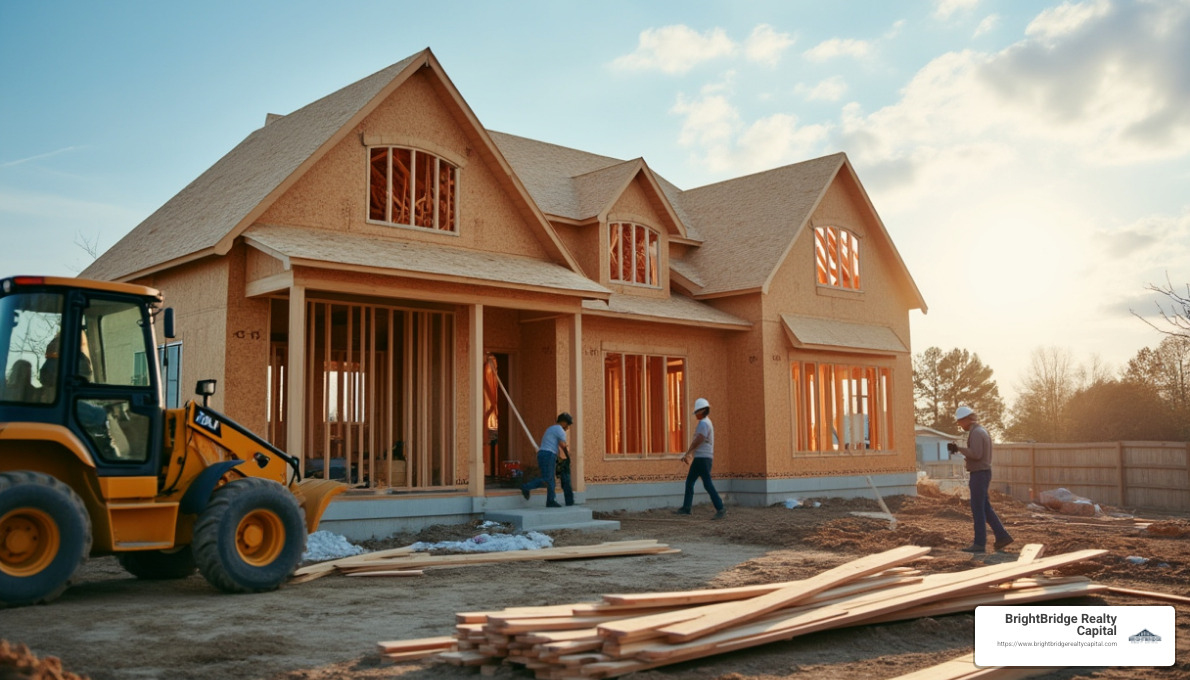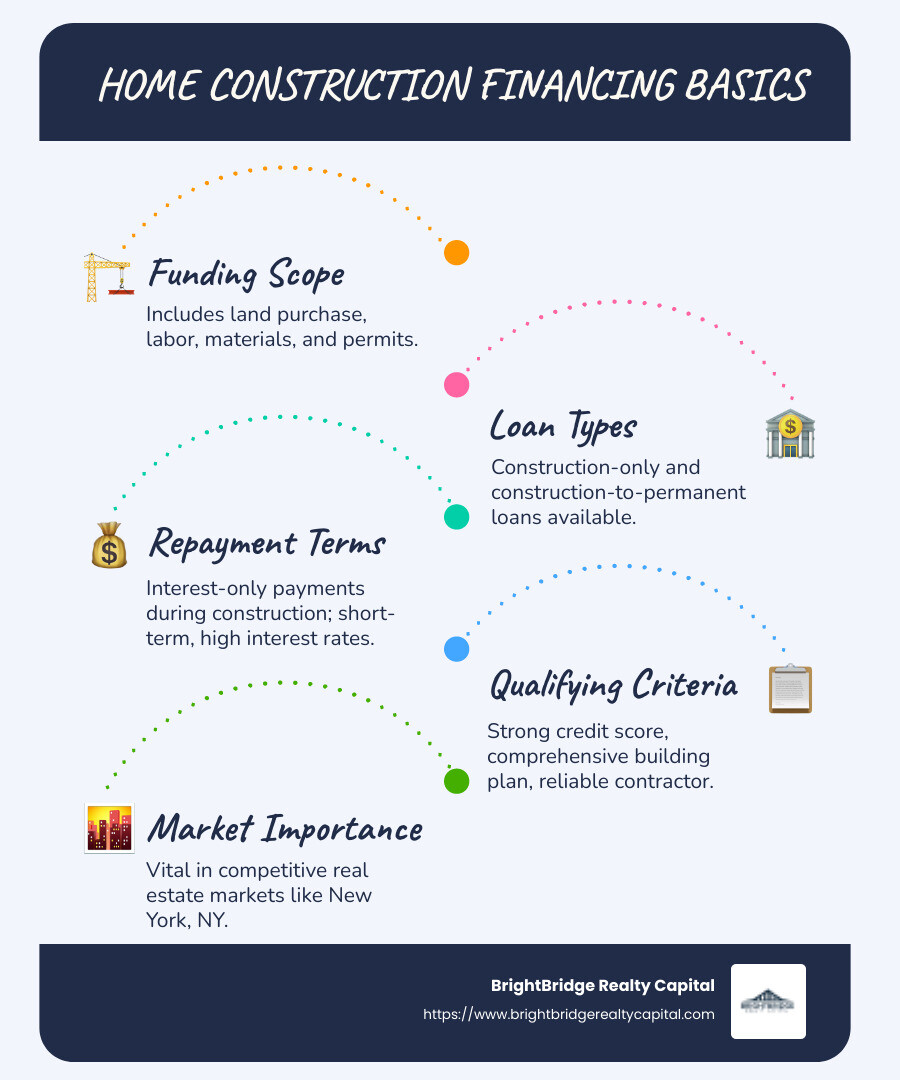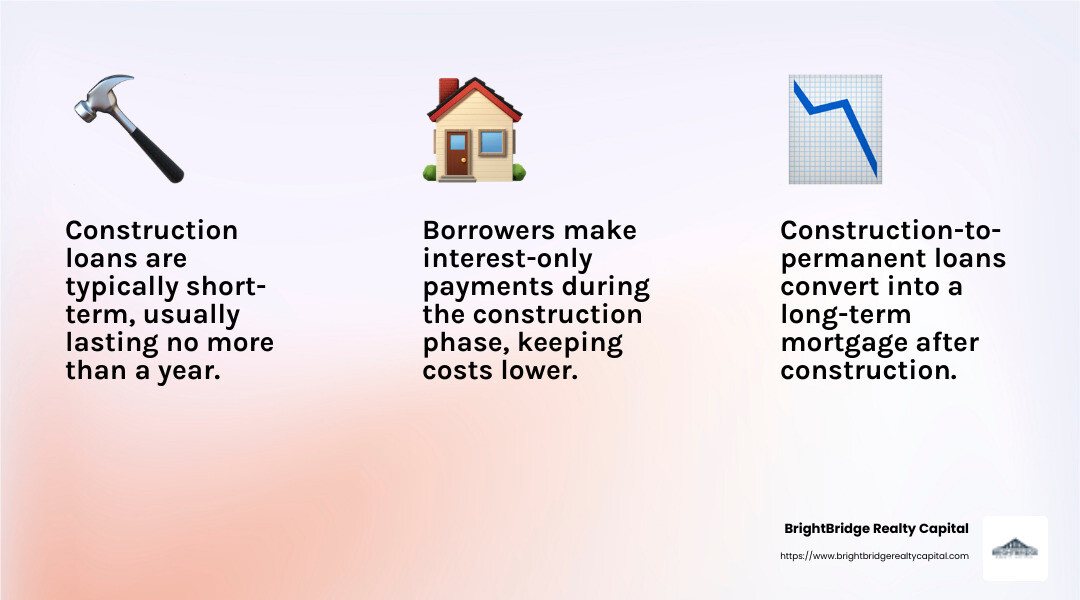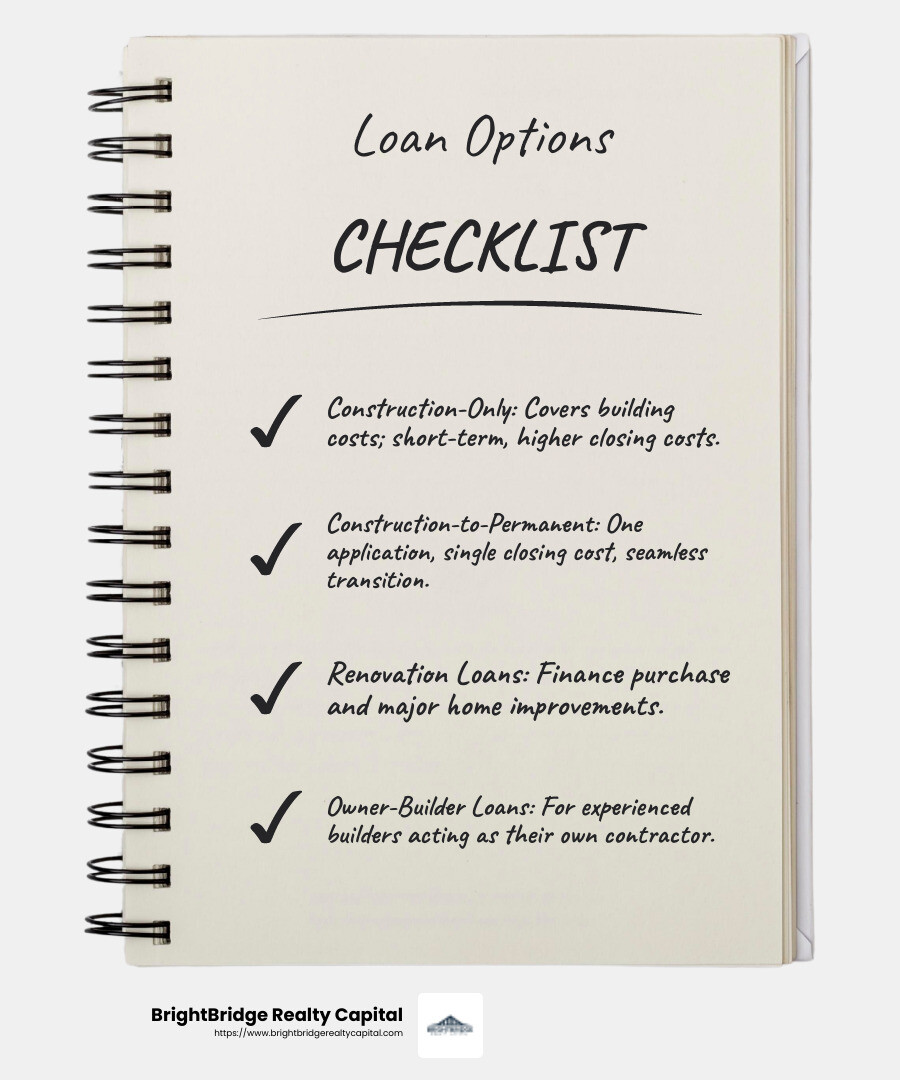Constructing Your Dream: Navigating Home Financing

Home construction financing allows you to take your dream house from blueprint to reality by providing the funds needed to cover the cost of building a new home. Whether you’re starting on a single-family project or a larger development, understanding the basics of this financing option is crucial.
Here's a quick overview if you want the essentials without diving in deeply:
- Funding Scope: Covers land purchase, labor, material costs, and permits.
- Loan Types: Includes construction-only loans and construction-to-permanent loans, which transition to traditional mortgages post-construction.
- Repayment and Terms: Typically require interest-only payments during construction and involve a short-term, high-interest rate compared to standard mortgages.
- Qualifying Criteria: Requires a strong credit score, a comprehensive building plan, and a reliable contractor.
Home construction financing is a vital tool, especially in competitive real estate markets like New York, NY. It offers aspiring home builders the financial foundation to create their perfect space, while potentially increasing property value and long-term investment returns.

Learn more about home construction financing:
- construction loan approval process
- construction loan credit requirements
- construction loan interest rates
Understanding Home Construction Loans
Home construction loans are unique financial products designed for building new homes. Let's break down the key features:
Short-Term Loans
Construction loans are typically short-term, usually lasting no more than a year. They provide the necessary funds to cover the construction costs, including land, labor, and materials. Because of their short-term nature, these loans often come with higher interest rates compared to traditional mortgages.
Construction-to-Permanent Loans
A popular option is the construction-to-permanent loan. This type of loan simplifies the financing process by combining the construction loan with a permanent mortgage. Initially, the borrower makes interest-only payments during the construction phase. Once the home is complete, the loan automatically converts into a long-term mortgage. This streamlines the transition from construction to homeownership, avoiding the need for multiple loan applications and closing costs.
Interest-Only Payments
During the construction phase, borrowers typically make interest-only payments. This means you only pay interest on the money that has been disbursed so far. This keeps payments lower during construction. Once the home is completed and the loan transitions to a permanent mortgage, standard principal and interest payments begin.

Understanding these elements of home construction loans can help you steer the financing process with confidence. Whether you're planning a new build or converting to a permanent mortgage, knowing these basics is key to making informed decisions.
Types of Home Construction Financing
When it comes to home construction financing, there are several options to consider. Each type of loan serves a specific purpose and caters to different needs. Here's a breakdown of the most common types:
Construction-Only Loans
A construction-only loan is designed to cover the costs of building a home. This loan is short-term, typically lasting about a year. Once construction is complete, the entire loan amount usually becomes due. Borrowers often pay off this loan by either refinancing into a traditional mortgage or paying cash. While this option allows flexibility in choosing a permanent mortgage later, it can be more costly due to two rounds of closing costs.
Construction-to-Permanent Loans
These loans provide a seamless transition from construction to mortgage. Initially, you receive a short-term loan to cover the construction costs. Once the home is built, the loan converts into a permanent mortgage. This means only one application and one set of closing costs. During construction, you make interest-only payments, which helps keep costs down until the home is completed.
Renovation Loans
If you're planning significant improvements to an existing home, a renovation loan might be the way to go. These loans, which include options like FHA 203(k) loans, finance large-scale renovations. Whether you're adding rooms or modernizing a kitchen, this type of loan covers both purchase and renovation costs, allowing you to make one monthly payment.
Owner-Builder Loans
For those with construction experience, an owner-builder loan can be an attractive option. This loan allows you to act as your own general contractor. However, it often requires proof of experience or licensing, as you will be responsible for overseeing the construction. This option can save costs on hiring a contractor, but it also requires significant time and expertise.
Land Loans
If you have your eye on a piece of land but aren't ready to build just yet, a land loan can help. This loan covers the cost of purchasing the land itself. You’ll need additional financing for construction. Land loans can be more challenging to secure and often come with higher interest rates, as they are considered riskier by lenders.

Each of these options has its own set of benefits and drawbacks. Choosing the right type of home construction financing depends on your specific situation, whether you're building from scratch, renovating, or simply purchasing land. Understanding these options will help you make informed decisions as you start on your home construction journey.
How to Qualify for a Home Construction Loan
Qualifying for a home construction loan requires meeting specific criteria. Here's what you need to know:
Credit Score
A strong credit score is crucial. Most lenders look for a minimum score of 620. This helps prove that you're a reliable borrower. A higher score can also help you secure better interest rates.
Debt-to-Income Ratio
Your debt-to-income (DTI) ratio is the percentage of your income that goes toward paying debts. Lenders prefer a DTI below 45%. This indicates you can handle new loan payments without financial strain.
Down Payment
Construction loans often require a larger down payment compared to traditional mortgages. Be prepared to put down up to 20%. This shows lenders you're committed and reduces their risk.
Builder Requirements
You'll need to choose a licensed builder or contractor. Lenders require a contract from a professional to ensure the project is viable. Make sure your builder meets any requirements set by your lender.
Documentation
Gather all necessary documents for your loan application. This includes:
- Construction plans and budget
- Builder contract
- Proof of land ownership or purchase agreement
- Personal financial documents, like pay stubs and tax returns
These documents help the lender assess the project's feasibility and your financial stability.
Meeting these requirements can smooth the path to securing a home construction loan. Once approved, you're one step closer to building your dream home.
The Home Construction Financing Process
Navigating the home construction financing process can seem daunting, but breaking it down into steps makes it manageable.
Loan Application
The first step is the loan application. This involves submitting detailed plans and budgets for your construction project. You'll need to provide documents like the builder's contract, proof of land ownership, and your financial records. Lenders want to see a realistic timeline and budget to ensure the project is feasible.
Draw Schedule
Once approved, the loan doesn't get handed to you in a lump sum. Instead, funds are released in stages, known as "draws." These are scheduled based on the project's progress. For example, you might receive a draw after the foundation is laid, another after the framing is completed, and so on. This ensures that funds are used appropriately and that the construction stays on track.
Inspections
With each draw, expect an inspection. Lenders send inspectors to check that the work is completed as planned before releasing the next round of funds. This keeps everyone accountable and ensures quality work. If something isn't up to standard, the draw may be delayed until issues are resolved.
Conversion to Permanent Mortgage
After construction is complete, the loan converts to a permanent mortgage. This is where a construction-to-permanent loan shines. It automatically transitions into a standard mortgage, eliminating the need for a separate closing. You'll start making regular mortgage payments, which include both principal and interest.
Understanding these steps can help you steer the home construction financing process with confidence. With the right preparation, you'll be well on your way to turning your dream home into a reality.
Frequently Asked Questions about Home Construction Financing
What is the minimum FICO score for a construction loan?
When it comes to qualifying for a construction loan, your credit score plays a big role. Most lenders require a minimum FICO score of 680. This is higher than what you'd typically need for a conventional mortgage. A strong credit score shows lenders that you're a responsible borrower, which is crucial when dealing with the complexities of home construction financing.
How do construction loan interest rates compare to traditional mortgages?
Construction loans usually have higher interest rates than traditional mortgages. Why? Because they carry more risk for lenders. Unlike a typical mortgage, a construction loan isn't backed by a completed home. Instead, it's based on a project in progress. Rates for construction loans can be about 1 percentage point higher than those for regular mortgages. Additionally, construction loans often have variable rates, meaning they can fluctuate with market changes.
What costs are covered by a construction loan?
A construction loan covers several key expenses involved in building a home. Here’s a quick breakdown:
- Land: You can use the loan to purchase the land where you'll build your home.
- Labor: Contractor fees and worker salaries are included.
- Materials: The cost of building materials, from concrete to windows, is covered.
- Permits: Necessary permits for construction are also part of the loan.
However, design costs, like hiring an architect, are usually not covered. You'll need to budget separately for those. Understanding what a construction loan covers can help you plan your finances more effectively as you start on building your dream home.
These FAQs should give you a clearer picture of what to expect when considering home construction financing. Up next, we'll dive into more details about how BrightBridge Realty Capital can streamline this process for you.
Conclusion
At BrightBridge Realty Capital, we understand that starting on a home construction project is a significant endeavor. Our goal is to make the process as seamless as possible for you. With our direct lending approach, we cut out the middleman, ensuring that you get competitive rates and a streamlined experience.
One of our standout features is our ability to offer fast closings—often within just a week. This speed not only helps you secure funding quickly but also allows you to take advantage of opportunities that require immediate action. Whether you're building from the ground up or renovating, having quick access to funds can make all the difference.
We pride ourselves on offering a simple and straightforward process. From your initial application to the final payoff, our team of real estate experts is here to guide you every step of the way. We handle all the details in-house, ensuring that you experience a hassle-free journey as you steer home construction financing.
Ready to take the next step? Explore our loan options and see how we can help you construct your dream home with ease.


